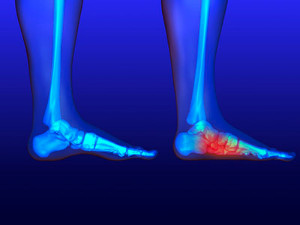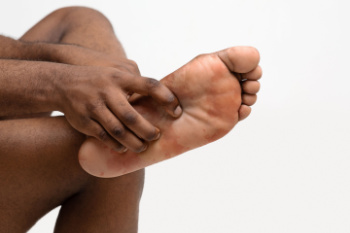
Lansdowne, PA
(610) 626-3338

Lansdowne, PA
(610) 626-3338
 The medical condition Pes Planus, or more commonly known as flat feet, is often noticeable while standing with your feet flat on the floor and no visible arch is present. Oftentimes babies are born with flat feet and the arch develops with age. There is a small percentage of adults who never develop an arch which is said to be caused by extended stress or a traumatic injury. Flat feet can also result from an abnormal foot structure, genetic factors, obesity, or an injury to the foot. The function of the arch is to help balance weight across the body, in addition to determining a walking style. If no pain coincides with flat feet immediate care is not needed, although shoe inserts or custom orthotics may be recommended to prevent future injuries. One common symptom of flat feet is foot pain, which can develop from strained ligaments and muscles. If you have flat feet it is strongly suggested to schedule an appointment with a podiatrist who can properly diagnose this condition and provide various treatment methods that are best for you.
The medical condition Pes Planus, or more commonly known as flat feet, is often noticeable while standing with your feet flat on the floor and no visible arch is present. Oftentimes babies are born with flat feet and the arch develops with age. There is a small percentage of adults who never develop an arch which is said to be caused by extended stress or a traumatic injury. Flat feet can also result from an abnormal foot structure, genetic factors, obesity, or an injury to the foot. The function of the arch is to help balance weight across the body, in addition to determining a walking style. If no pain coincides with flat feet immediate care is not needed, although shoe inserts or custom orthotics may be recommended to prevent future injuries. One common symptom of flat feet is foot pain, which can develop from strained ligaments and muscles. If you have flat feet it is strongly suggested to schedule an appointment with a podiatrist who can properly diagnose this condition and provide various treatment methods that are best for you.
Flatfoot is a condition many people suffer from. If you have flat feet, contact Dr. George Yarnell from Pennsylvania. Our doctor will treat your foot and ankle needs.
What Are Flat Feet?
Flatfoot is a condition in which the arch of the foot is depressed and the sole of the foot is almost completely in contact with the ground. About 20-30% of the population generally has flat feet because their arches never formed during growth.
Conditions & Problems:
Having flat feet makes it difficult to run or walk because of the stress placed on the ankles.
Alignment – The general alignment of your legs can be disrupted, because the ankles move inward which can cause major discomfort.
Knees – If you have complications with your knees, flat feet can be a contributor to arthritis in that area.
Symptoms
Treatment
If you are experiencing pain and stress on the foot you may weaken the posterior tibial tendon, which runs around the inside of the ankle.
If you have any questions, please feel free to contact our office located in Lansdowne, PA . We offer the newest diagnostic and treatment technologies for all your foot care needs.

Plantar fasciitis is often explained simply as heel pain caused by irritation of the thick band of tissue along the bottom of the foot. While this is true, there is more to understand. The condition develops when repetitive stress causes small tears in the fascia, leading to inflammation. But not everyone with heel pain has plantar fasciitis, and not every case responds the same way. Factors like foot structure, tight calf muscles, and wearing poor footwear can worsen the strain. Long hours of standing or sudden increases in activity also play a role. Beyond basic stretching and rest, treatment may include custom orthotics, night splints, or other advanced podiatric options. Addressing plantar fasciitis early can shorten recovery time and prevent chronic heel pain. If discomfort in your heel is interfering with your routine, it is suggested that you see a podiatrist for a diagnosis and appropriate treatment.
Plantar fasciitis can be very painful and inconvenient. If you are experiencing heel pain or symptoms of plantar fasciitis, contact Dr. George Yarnell from Pennsylvania. Our doctor can provide the care you need to keep you pain-free and on your feet.
What Is Plantar Fasciitis?
Plantar fasciitis is the inflammation of the thick band of tissue that runs along the bottom of your foot, known as the plantar fascia, and causes mild to severe heel pain.
What Causes Plantar Fasciitis?
How Can It Be Treated?
While very treatable, plantar fasciitis is definitely not something that should be ignored. Especially in severe cases, speaking to your doctor right away is highly recommended to avoid complications and severe heel pain. Your podiatrist can work with you to provide the appropriate treatment options tailored to your condition.
If you have any questions, please feel free to contact our office located in Lansdowne, PA . We offer the newest diagnostic and treatment technologies for all your foot care needs.

Falls around the house are a major concern for seniors and can lead to serious foot problems, such as fractures, sprains, and wounds that take longer to heal. Prevention begins with simple daily habits. Do not rush when moving from place to place, and have medications reviewed to reduce side effects that affect balance. Additionally, wear supportive shoes indoors and outdoors, and have vision and hearing checked regularly to improve awareness of surroundings. A podiatrist can treat foot or ankle injuries from falls, recommend proper footwear, and provide strategies to improve stability and safety. If you or a loved one have foot pain from falling, it is suggested that you consult a podiatrist who can treat various foot and ankle injuries, and guide you on additional falls prevention tips.
Preventing falls among the elderly is very important. If you are older and have fallen or fear that you are prone to falling, consult with Dr. George Yarnell from Pennsylvania. Our doctor will assess your condition and provide you with quality advice and care.
Every 11 seconds, an elderly American is being treated in an emergency room for a fall related injury. Falls are the leading cause of head and hip injuries for those 65 and older. Due to decreases in strength, balance, senses, and lack of awareness, elderly persons are very susceptible to falling. Thankfully, there are a number of things older persons can do to prevent falls.
How to Prevent Falls
Some effective methods that older persons can do to prevent falls include:
Falling can be a traumatic and embarrassing experience for elderly persons; this can make them less willing to leave the house, and less willing to talk to someone about their fears of falling. Doing such things, however, will increase the likelihood of tripping or losing one’s balance. Knowing the causes of falling and how to prevent them is the best way to mitigate the risk of serious injury.
If you have any questions, please feel free to contact our office located in Lansdowne, PA . We offer the newest diagnostic and treatment technologies for all your foot care needs.

Webbed toes, also called syndactyly, occur when two or more toes are joined together at birth. This condition develops during fetal growth when the tissue between toes does not fully separate. Webbed toes may appear alone or as part of a genetic condition, and the type depends on how much tissue is involved. In simple syndactyly, only skin and soft tissue connect the toes. Complex syndactyly involves bones, with some or all toes fused together. Complicated syndactyly goes further, where abnormal bone or tendon formation creates additional changes in the foot. The most common form affects the second and third toes, but fusion can also occur between the fourth and fifth toes. A podiatrist can evaluate the extent of fusion, discuss whether surgery is needed to improve function or appearance, and guide the recovery process. If you have a child born with webbed toes, it is suggested that you schedule an appointment with a podiatrist for an exam, diagnosis, and treatment.
Congenital foot problems require immediate attention to avoid future complications. If you have any concerns, contact Dr. George Yarnell of Pennsylvania. Our doctor can provide the care you need to keep you pain-free and on your feet.
Congenital foot problems are deformities affecting the feet, toes, and/or ankles that children are born with. Some of these conditions have a genetic cause while others just happen. Some specific foot ailments that children may be born with include clubfeet, polydactyly/macrodactyly, and cleft foot. There are several other foot anomalies that can occur congenitally. What all of these conditions have in common is that a child may experience difficulty walking or performing everyday activities, as well as trouble finding footwear that fits their foot deformity. Some of these conditions are more serious than others. Consulting with a podiatrist as early as possible will help in properly diagnosing a child’s foot condition while getting the necessary treatment underway.
What are Causes of Congenital Foot Problem?
A congenital foot problem is one that happens to a child at birth. These conditions can be caused by a genetic predisposition, developmental or positional abnormalities during gestation, or with no known cause.
What are Symptoms of Congenital Foot Problems?
Symptoms vary by the congenital condition. Symptoms may consist of the following:
Treatment and Prevention
While there is nothing one can do to prevent congenital foot problems, raising awareness and receiving neonatal screenings are important. Early detection by taking your child to a podiatrist leads to the best outcome possible.
If you have any questions, please feel free to contact our office located in Lansdowne, PA . We offer the newest diagnostic and treatment technologies for all your foot care needs.